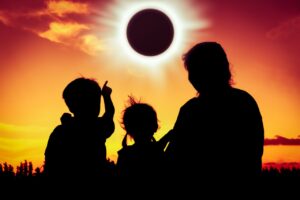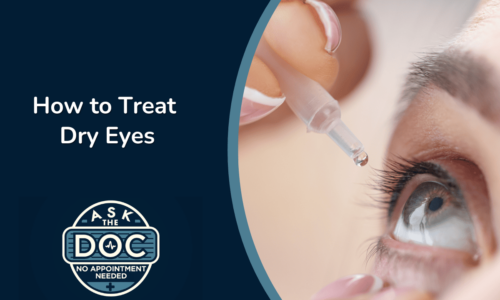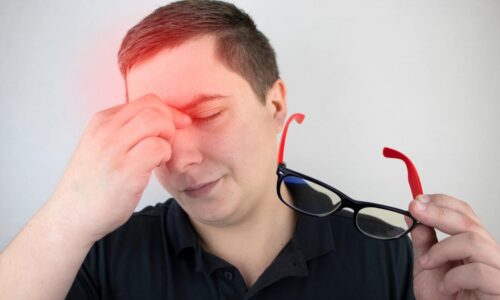What is the safe way to observe a solar eclipse? |

You may have heard that there will be an eclipse on August 21, 2017 and that people are planning to view it in specific cities in the U.S. On that date, the Sun, Moon, and Earth’s orbits will line up such that the moon will completely cover the sun, casting a shadow on an arc from Salem, Oregon, to Charleston, South Carolina (called the “path of totality”). Observers outside this path will still see a partial solar eclipse where the moon covers part of the sun’s disk.
I’ve had some questions about eye safety while watching the eclipse. To begin, I think we need to understand what is happening so we can appreciate the rationale and risks.
Do you know the difference between a lunar and a solar eclipse?
A lunar eclipse occurs when the Earth’s orbit passes between the Sun and the Moon and blocks the Sun’s rays from directly reaching the Moon. A solar eclipse, by contrast, occurs when the moon blocks the light of the sun from reaching the Earth, casting a shadow onto Earth. Standing in the narrow path of the shadow, the sky appears very dark as if it were night. Solar eclipses happen once every 18 months. Unlike lunar eclipses, solar eclipses only last for a few minutes. Lunar eclipses are not dangerous to look at because you are essentially staring at the Moon, not the Sun.
How exactly does an eclipse harm the eye?
Many people wrongly assume that since it is dark during the eclipse, it is safe to look up at the blocked sun. While it is true that it is safe to look at a full solar eclipse, the rays are only blocked for a few minutes, and only in the “path of totality”. So first of all, if you are not in the full shadow of the moon (viewing a partial eclipse) you are exposing your eyes to direct sun rays. Secondly, if you are in the path of totality, the moon will only cover the sun fully for a few minutes – the rest of the time it will be partially covered, allowing rays to penetrate the eyes.
When excessive sun rays reach the eyes, they can cause photokeratitis, or a sunburn of the eye. The eyes will become red, and have a “foreign body sensation” (as if something is in the eye) with increased tear production and sensitive to light. If sun rays are allowed into the eyes for a longer period of time, their UV radiation can cause solar retinopathy, which results in permanent damage and possible blindness from complex chemical reactions within the rods and cones of the retina. The radiation can essentially cook the tissue in the back of the eye!
How do I protect my eyes if I want to watch a solar eclipse?
The only safe way to look directly at the uneclipsed or partially eclipsed sun is through special-purpose solar filters, such as “eclipse glasses” (available for purchase here) or hand-held solar viewers. Homemade filters or ordinary sunglasses, even very dark ones, are not safe for looking at the sun; they transmit thousands of times too much sunlight.
NASA makes the following safety recommendations:
- Always inspect your solar filter before use; if scratched or damaged, discard it. Read and follow any instructions printed on or packaged with the filter.
- Always supervise children using solar filters.
- Stand still and cover your eyes with your eclipse glasses or solar viewer before looking up at the bright sun. After looking at the sun, turn away and remove your filter – do not remove it while looking at the sun.
- Do not look at the uneclipsed or partially eclipsed sun through an unfiltered camera, telescope, binoculars, or other optical device.
- Similarly, do not look at the sun through a camera, a telescope, binoculars, or any other optical device while using your eclipse glasses or hand-held solar viewer – the concentrated solar rays will damage the filter and enter your eye(s) causing serious injury.
- Seek expert advice from an astronomer before using a solar filter with a camera, a telescope, binoculars, or any other optical device. Note that solar filters must be attached to the front of any telescope, binoculars, camera lens, or other optics.

If you are within the path of totality remove your solar filter only when the moon completely covers the sun’s bright face and it suddenly gets quite dark. Experience totality, then, as soon as the bright sun begins to reappear, replace your solar viewer to look at the remaining partial phases.- Outside the path of totality, you must always use a safe solar filter to view the sun directly.
- If you normally wear eyeglasses, keep them on. Put your eclipse glasses on over them, or hold your handheld viewer in front of them.
Full solar eclipses are an extraordinary site – just be careful that this one doesn’t leave your eyes with permanent consequences!
References:
https://eclipse2017.nasa.gov/safety
https://nasa.tumblr.com/post/163907904239/counting-down-to-the-solar-eclipse-on-august-21
https://www.theatlantic.com/science/archive/2017/08/advice-for-eclipse-newbies/536010/?utm_source=atltw
http://www.visioneyeinstitute.com.au/article/dark-side-sun/
If you have any more questions just Ask Hanna, our health advisors are here to help.
Dr. Val Jones MD – Health Tip Content Editor
Image: ©Shutterstock / kdshutterman








